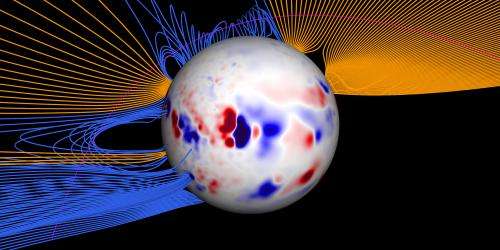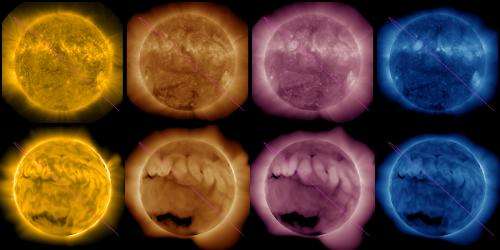June 7, 2013 report
Comet Lovejoy's wiggle offers glimpse of Sun's variable coronal magnetism (w/ video)

(Phys.org) —A team of researchers studying comet Lovejoy has discovered that as the ball of ice passed through the sun's corona in December 2011, its tail wiggled in a way that allowed them to better understand coronal magnetism. In their paper published in the journal Science, the team says observations of Lovejoy's close call with the sun have helped them improve models used to describe the irregular nature of coronal magnetism.
Comet Lovejoy is part of a class of comet's known as Kreutz sungrazers—they are believed to be remnants of a much larger comet that broke apart hundreds of years ago. They're called sungrazers because they have a tendency to strike the sun's corona at an angle. Most break apart and disappear—Lovejoy did not. Instead it spun around the sun at very high velocity and shot back out into space, only to break apart several days later. Sungrazers offer researchers a unique way to study the sun's corona—it's too hot to send a probe—temperatures typically hover in the millions of degrees. Instead they can watch what happens to comets as they are impacted by intense temperatures and magnetism.
What the researchers found most interesting about Lovejoy's close call was the movement of its tail as it passed though parts of the corona—it wiggled, displaying major changes in intensity, direction, persistence and magnitude. Suspecting the wiggling was due to interactions between the ions that make up the comet's tail and magnetism from the corona, the researchers sought to reproduce the effect using models—one of which gave a close approximation of the real thing, suggesting a high degree of accuracy.

Gaining a better understanding of coronal magnetism has become more critical as Earth-bound technology has become more sophisticated. Solar flares and storms can disrupt satellite communications and other electronic equipment and in some cases the grid itself.
Comet Lovejoy came within 140,000 kilometers of the surface of the sun—its path was traced using ultraviolet light based equipment at facilities such as the Solar Terrestrial Relations Observatory and the Solar Dynamics Observatory. The researchers are hoping that their models will one day be able to help with space weather forecasting, giving operators of sensitive equipment time to shut down before it's too late.
More information:
Probing the Solar Magnetic Field with a Sun-Grazing Comet, Science 7 June 2013: Vol. 340 no. 6137 pp. 1196-1199
DOI: 10.1126/science.1236550
ABSTRACT
On 15 and 16 December 2011, Sun-grazing comet C/2011 W3 (Lovejoy) passed deep within the solar corona, effectively probing a region that has never been visited by spacecraft. Imaged from multiple perspectives, extreme ultraviolet observations of Lovejoy's tail showed substantial changes in direction, intensity, magnitude, and persistence. To understand this unique signature, we combined a state-of-the-art magnetohydrodynamic model of the solar corona and a model for the motion of emitting cometary tail ions in an embedded plasma. The observed tail motions reveal the inhomogeneous magnetic field of the solar corona. We show how these motions constrain field and plasma properties along the trajectory, and how they can be used to meaningfully distinguish between two classes of magnetic field models.
Journal information: Science
© 2013 Phys.org



















